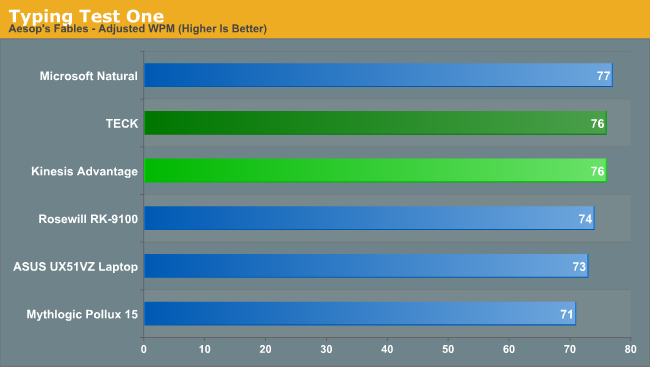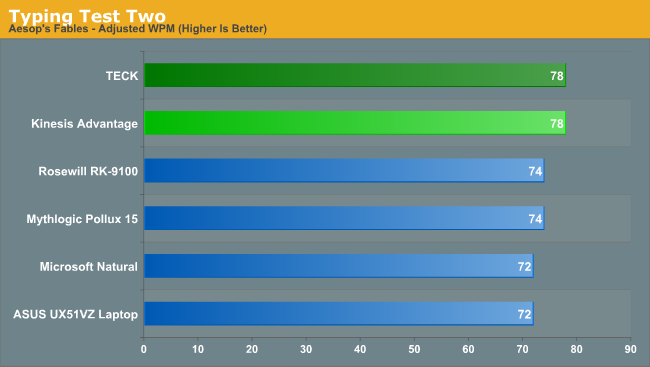Kinesis Advantage Review: Long-Term Evaluation
by Jarred Walton on July 2, 2013 10:15 PM ESTMore Subjective Thoughts and Typing Speed Results
So far I’ve covered a ton of items that may or may not affect individual users, but the real questions are almost certainly not yet covered. Is the Kinesis more comfortable for typing than typical keyboards, is it better than the TECK, and what about typing speed—did it make me a faster typist? I’ll tackle the last item in that list first, as it’s probably the easiest one to answer.
As far as the regular typing tests that I’ve tried on other keyboards, let me first start by saying that I feel like I’m mostly “tapped out” on speed, regardless of what keyboard I happen to be using. I can’t say whether or not Dvorak or some other layout could further improve my speed, but most things I’ve read suggest at best a 5-10% performance in typing speed, and that’s after potential a month or more of training and acclimation to get used to the alternate layout (and some difficulties every time you switch to a system that doesn’t use a Dvorak layout).
What that means for me in particular is that I generally won’t break 80WPM—I just don’t have it in me. I have a sister-in-law who is an accomplished pianist, and she can hit 100+ WPM on a regular keyboard, and I know others that can pull off that feat as well. Personally, 60-70 WPM is plenty fast for what I do, as most of the time I’m sitting at the computer I need to think of what to write more than I wait for my fingers to put thoughts to text.
Since I’ve now tested two ergonomic keyboards along with using regular keyboards and laptops, I can at least make some graphs—hey, it’s AnandTech and I know you all want graphs, right? The margin of error for these sorts of tests is much greater I think, so consider anything within 3 WPM to be essentially a tie. For this roundup, I’ve got my results from the TECK, the Kinesis Advantage, the Rosewill RK-9100, an MS Natural (old model PS/2 connector from about ten years ago), and just for good measure I threw in results using ASUS UX51VZ and Mythlogic Pollux 15 laptops (the latter uses a keyboard similar to the MSI SteelSeries, only on a Clevo chassis).
Given the amount of time I’ve now spent taking the various typing tests, I felt it would be best for me to go back and retake tests on some of the other keyboards, so scores are changed from my previous typing speed articles. I repeated each test multiple times on a keyboard until I felt I had a run that was representative of the best I could reasonably manage—where I’d expect to end up if I used the keyboard as my sole option for a while. I also tried taking the test again on the TECK, and unfortunately even after 20 tries I just wasn’t getting very good results; it seems that a couple months without every day use of the TECK was enough for me to start losing muscle memory of where the keys are located. For the TECK, I used the best results that I obtained when I was at my peak, at the time I finished the TECK review.




At the very least, in what is a less deterministic metric, I seem to consistently top out at around the same point on the various keyboards. In some cases I’m slightly faster on the two mechanical ergonomic keyboards, but overall most of the results are close enough to be considered a tie.
Where I’m absolutely not doing that well on the TECK and Advantage is in 10-key speed, and the laptops with their slightly smaller [0] keys are also suffering. Interestingly, I did best on the 10-key with the old MS Natural—and I confirmed that 10K+ result several times. The Rosewill should be similar, but I consistently scored in the 9000-9500 range (sometimes even dropping into the 8500-9000 range). The absolute best results I got on both the TECK and Kinesis are listed in the charts, and while practice might help me improve I have to be honest: their 10-key implementations leave a lot to be desired. The TECK in particular has the various keys all over the place, while the Kinesis is mostly just a case of being a little different than a typical 10-key.
One nice aspect of the Kinesis 10-key is that the “Keypad” button actually affects more than just the numeric keypad, which can be somewhat useful at times, but more importantly if you plug into a system that has NumLock active you won’t immediately get numbers—the NumLock function of the Kinesis exists separately from the 10-key. So if you want the cursor keys and document navigation keys on the right hand, you can get that functionality.
In terms of speed, then, these high-end ergonomic keyboards don’t appear to add much to my typing speed, but at least after training I’m not any slower. Others are likely to have better/worse results—some will see more, and undoubtedly some will see lower speeds (particularly early on in the use of a new keyboard)—but for the most part typing speed doesn’t seem to change much with keyboard. For speed purposes then, I wouldn’t recommend people go and shell out $200-$300 (or more) on a mechanical ergonomic keyboard, but what about for other benefits?
I feel when using both the TECK and Kinesis that I have to reach and move my hands and fingers around less. Some might say that’s a bad thing (i.e. it might make you more stiff and cause you to tighten up muscles in the hands and fingers), but at least in terms of how it feels I have to say that less stretching to reach keys is more comfortable for me. More comfortable however doesn’t mean that the use of such keyboards is a way to “cure/fix” CTS/RSI/tendonitis issues caused by frequent use of a computer keyboard. Every keyboard I’ve seen carries some form of warning about the risks of extensive typing, with recommendations to take breaks, stretch, etc. The Kinesis and TECK are no different, and if you need to really see about addressing health related concerns brought on by excessive typing, you’ll probably want to look at something that doesn’t require use of a keyboard at all (e.g. Dragon Naturally Speaking).
As for what this means to me personally, I cannot say that my hands and wrists feel substantially better after using either keyboard, but at the same time I would say they’re definitely no worse. Perhaps an MRI or some other diagnosis would be able to shed more light on the subject, but for now I’m willing to leave it be. I enjoyed using both keyboard for various reasons, and I have my gripes about each design as well. Which is better is a matter of preference, but since this is my own review/opinion piece let’s get to the conclusion.










67 Comments
View All Comments
JarredWalton - Wednesday, July 3, 2013 - link
Honestly, the hardest part is that just when I reach the point where I'm thinking, "Yeah, I actually like this keyboard a lot and could see myself sticking with this particular model..." I have to unplug it and start testing the next one. Argh! I admit to being a bit shocked at how bad I was at typing on the TECK after a two month break; it will be interesting to see if the same thing happens with the Advantage once I put it aside and start using the ErgoDox daily in its place.gwolfman - Wednesday, July 3, 2013 - link
Jarred, you mentioned Dragon in your article. I know Anand (at least used to) uses Dragon a lot. Can you ask him to write a companion article on his experiences with Dragon? Or do that + you take up Dragon and give your hands a break entirely from the keyboard! I tried Dragon for a few semesters while in college, but haven't touched it in quite a while. Please chime in.JarredWalton - Wednesday, July 3, 2013 - link
Actually, I think you're remembering my Dragon articles -- I'm not sure that Anand has done much with Dragon in recent years. I've got a copy and a microphone to use with it, and now I just need to spend some time testing....gwolfman - Monday, July 8, 2013 - link
Yeah, I Sounds great, I'm looking forward to it.damonlynch - Wednesday, July 3, 2013 - link
I've been using the Kinesis keyboard since the mid-1990s. Like others my first model was pre-USB, and for about 10 years now I have the same model reviewed. I love it! I find the keyboard macros are helpful for things like my name (mapped to Shift+Backspace), my email address, website etc.The only maintenance aspect of the keyboard that is required after long-term use is to occasionally replace the foam pads. Those pads really make a difference if you are like me and rest your arms on the palm rest when not typing.
The other thing to be aware of is USB 3.0. Kinesis write (grammatical error included) "Advantage keyboard’s currently do not work with Intel based USB 3.0 ports on Windows 7 operating systems. The Advantage however will work with Intel based USB 3.0 ports with other operating systems, including Windows 8, Mac & Linux. The Advantage should work with most other non-Intel USB 3.0 chipset manufacturers and Windows 7."
7amood - Wednesday, July 3, 2013 - link
Hello Jarred, Get an A4Tech A-Shape keyboard for a review and make sure it is not a slim model. You will enjoy the most comfortable ergonomic typing on a standard keyboard layout. There is no learning curve, you just put your hands and start typing. Your hands will give you the happiest feedback you'll ever get from typing on a keyboard ever. I used one for years 10 years before I had the courage to retire it and get a normal mechanical keyboard (Logitech). I would love to hear your thoughts about it.flowrush - Thursday, July 4, 2013 - link
Just a note that the prices on those kb's can be had for a good deal cheaper if you don't buy directly on manufacturer's site. See here - http://search.thehumansolution.com/search?vwcatalo...Azethoth - Saturday, July 6, 2013 - link
Now I miss my old original white MS Naturals. The silver black ones I replaced them with sucked and I jumped ship to G keys and Logitech. Currently Corsair K-90 with mechanical keys. Its got the lame non split layout and is also spaced closer than I want so lots of double key hits and the keys are twitchy and double tapping a lot.My perfect keyboard: I really just want the MS split key layout but with G keys and mechanical keys. (existing inverted T arrow keys and num pad mandatory of course). I would be happy to banish caps lock, insert, num & scroll lock to the bottom of the keyboard. Also textured ESDF keys (with spare WA as well for the sheeple). This hardware remapping sounds good as well.
z0phi3l - Monday, July 8, 2013 - link
Just looking at that thing and my wrists started hurting, not sure why it's called ergonomic, it looks more like a wrist torture deviceJarredWalton - Tuesday, July 9, 2013 - link
Don't knock it until you try it. :-p